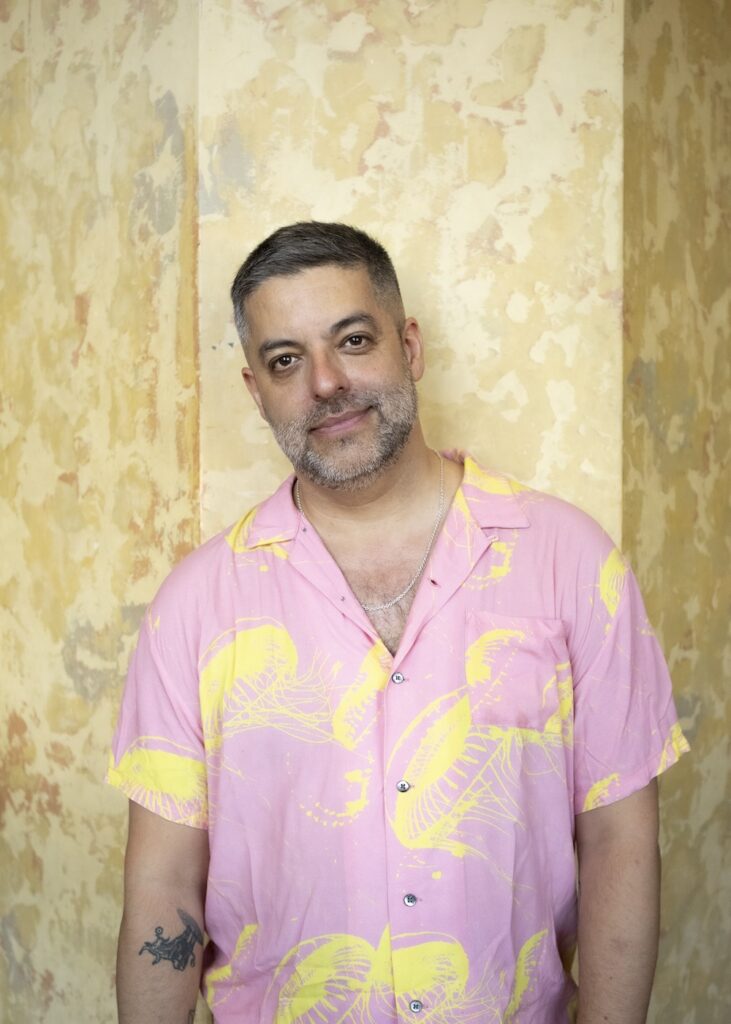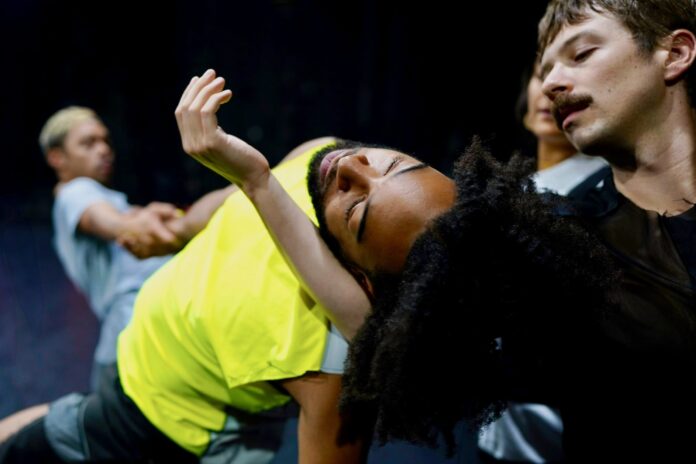Miguel Gutierrez’s Super Nothing (Fri/28-Sun/2 at ODC, SF) asks how dance can confront the constant grief we experience in our lives. A cast of four dancers explores how people support each other to survive, moving through depictions of the past to create a blueprint for a new future. Over the past few years, Gutierrez has developed an interest in creating “choreography for the end of the world.” That’s definitely something we are all thinking about these days.
Gutierrez, more than just a dancer and choreographer, has his hands in the visual arts and music as well, with a BA in theater and dance from Brown University and an MFA in studio art from the School of Art Institute of Chicago. Being a certified Feldenkrais practitioner is yet another way for him to reflect on the possibilities of the human body.
He splits his time between Lenapehoking (land of the Lenape indigenous people), also known as Brooklyn, NY and Tovaangar (land of the Tongva native people), or Los Angeles, where he is an Associate Professor of Choreography at UCLA in the department of World Arts and Cultures/Dance, and also serves as the Vice-Chair of the MFA in Choreographic Inquiry. He spends a significant portion of his time on the road, both nationally and internationally, showing his work, and as a visiting lecturer and guest artist at universities and dance festivals.
On the telephone from Perth, Australia, Gutierrez, the son of Colombian immigrants, outlines how he became a dancer. “My sister was a cheerleader and I used to go watch her practices and copy them and teach myself the things they were doing,” he says. “When I was about nine I started going to a local dance school in New Jersey that would mostly do musical comedy and acrobatics classes. I took jazz class for a couple of years.”
In 1990, Gutierrez came to San Francisco to take part in the New Pacific Academy (NPA) education and training program for young LGBTQ activists. It was a program of the Critical Literacy Institute, a non-profit founded in 1989 by Luke Adams and Cleve Jones, of AIDS Memorial Quilt fame, to merge inquiry and action with a curriculum covering the fundamentals of activism, LGBTQ history, organizing skills, health issues, and diversity.
“My sister had been living in San Francisco since I was 17,” he says. “So I stayed. I mostly was involved in the queer activist scene, but then I started seeing [performance] work and I saw Contraband [directed by Sara Shelton Mann] for the first time and saw Keith [Hennessy].
“This is all happening in 1991. Then I saw Rick Darnell and The High Risk group for the first time and I started taking a dance class he was teaching. I didn’t know that you could do what he was doing with dance, and then I realized this is the thing that I want to do, so I went back to school. I started seeking out whatever version of that I could find.”
Gutierrez ended up learning about post-modern dance, working with a choreographer in Rhode Island, then transferring to NYU’s Tisch School of the Arts intending to get a degree. After only a year he left and got a job dancing with SF’s own Joe Goode Performance Group where he worked from 1993 to 1996. He also performed with the late Jess Curtis in one of his first pieces. “When I moved to New York,” he says, “I feel that I still really hold on to things about San Francisco, and the work there. That became more valuable to me once I left, and I could hold on to and think about them.”

Going on to build his career as a dancer and choreographer, Gutierrez racked up an impressive number of honors, including a Guggenheim Fellowship, four NY Dance and Performance “Bessie” Awards, and the Doris Duke Artist Award.
Explaining the development of Super Nothing, Gutierrez says: “I was approached by the Maggie Allessee National Center for Choreography, which is a choreographic research center attached to Florida State University in Tallahassee. I’ve had a lot of residencies there between 2006 and 2015 and they have an on-site videographer who documents a lot of the rehearsals. They usually interview all the collaborators, and you as the choreographer. They had hours and hours of footage of my work. In my instance, they had gotten support from the Mellon Foundation for an archive residency.”
Watching the videos with an eye to utilize them for his next piece, Gutierrez saw “many different aspects about the process, things that were in the rehearsal that didn’t make it into the show, or dynamics that were in the room, or my own way of directing, or the ways in which I did or didn’t deal with the energy in the room. I was also thinking about mapping those rehearsal periods to what was happening in the world at the time. Thinking about what did or did not enter the room in a conscious way. That got me into thinking about what happens in a rehearsal—like what’s possible or what’s not possible depending on who’s in the room.
“I’m not a nostalgic person by nature and so I don’t ever feel a big impulse towards reviving my past work and thinking how great this thing I made once is. I just don’t really think that way. I was more interested to bring in some new performers and talk with them about these different things I’m seeing in the process or it would be interesting to sort of revive some things that were more interstitial behaviors that weren’t considered part of the dance.
“I started teaching at UCLA three years ago, and I now live in LA, but I still have my place in New York. So I was thinking about the experience of moving and what it is to engage in a different community. What I was learning and unlearning by being in the LA dance scene. So I asked two people from the LA scene and two people from the New York scene to be in this project and to reflect the two places where I’m spending time now.”
Although Gutierrez often employs text-heavy passages in his work, a New York Times review of Super Nothing notes that “the piece communicates almost entirely through movement, driven by the thumping beats of Rosana Cabán’s immersive sound design. The exception is an introductory poem that urges us to surrender our attention, and asks: ‘What will happen? What will happen to us?’…. The relationships here [are] rife with both tenderness and struggle.”
“I’m the kind of person who just opens his mouth and speaks,” Gutierrez told dance legend Bill T. Jones in an interview last month. “I think I get that from my dad. He was the kind of person with a very clear moral compass of what was right and what was wrong. I feel charged to carry that forward. I hate when propriety and professionalism create filters that prevent us from speaking about this truthfully.”
SUPER NOTHING by Miguel Guttierez runs Fri/28-Sun/2 at ODC, SF. More info here.





